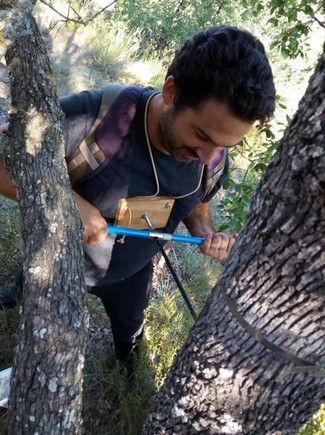A study carried out at the Forest Sciences Centre of Catalonia (CTFC) allows for the quantification of forests long-term growth and drought stress according to its management. These results enable management optimization and customization in order to adapt forests to climate change uncertainties and increase wood quality.
Solsona, September 2017. Thinnings are one of the main forest management tools, in which smaller trees are removed so the rest can grow better without competing for resources. For the first time, a research sets numbers to the future of a forest when this type of management is carried out, both in terms of water availability and productivity. Knowing these parameters according to the thinning intensity and the climate forecasts, will allow flexible and specific management recommendations to each case.
The research includes different scenarios varying according to the forest location and climate predictions. Aitor Ameztegui, member of the research group and author of the article, defines results as “a realistic approach that allows to anticipate the future of forests and puts the foundations of a forest management adapted to climate change”.
The study, published in Ecological Modelling, has focused on Scots pine forests in Catalonia. This species, important both ecological and economically, occupies 17% of the Catalan forest area and contributes more than 25% of the wood obtained from Catalan forests annually. In addition, climate predictions indicate that a large part of populations of this species may be threatened by drought in coming decades.
In order to carry out the research, 3 representative zones of the climatic gradient where the Scots pine is present were selected: Pyrenees as a wetland, Prades mountains as a dry area, and pre-Pyrenees as an intermediate zone. These data, together with different intensities of thinnings, have been the starting point to know the response of the forest in the long term by means of mathematical models.
The optimum thinning intensity
In all cases, as Ameztegui explains, “removing trees seems to have a positive effect on water availability, the challenge and utility is to see where the optimal point is between this gain and the loss of other goods and services these forests offer, since they depend on the place they are, whether it is dry or humid, and how the climate will change”.

Aitor Ameztegui during field work. Photo: Javier de Dios (CTFC)
According to the results of the study, in humid areas where the stress level due to drought will not be so high, making a thinning of medium or low intensity could improve productivity without affecting water availability.
In dry areas, however, in order to lower the level of stress below critical values, strong thinnings which may compromise good wood production are required. In these cases, it would be necessary to make periodic thinnings aimed at increasing the availability of water. Antoine Cabon, co-author of the article explains in this sense that “knowing when the effect of thinnings last could be used as a guide to design specific management plans.”
Despite the utility of the thinnings, Ameztegui warns that “there are no general recipes valid for all cases” and emphasizes the “need to make personalized management plans for each case, in order to achieve a balance between the gain in the productivity of the forest and in the availability of water that could be obtained from the thinning. ”
These models have great potential to be developed and improved, taking into account different management objectives and under a climate uncertainty scenario. Adding other variables such as soil erosion, mushroom production or biodiversity, would help develop forest management tools that guarantee multiple goods and services that these ecosystems offer us.
Forest dynamics models are very powerful tools to understand forests, assess their state and predict the future. This information is especially relevant in a context of global change, even further in the Mediterranean region, where climate predictions point to longer and more intense droughts, affecting growth and mortality of trees.
Ameztegui, A., Cabon, A., De Caceres, M., Coll, Ll. (2017) Managing stand density to enhance the adaptability of Scots pine stands to climate change: A modelling approach. Ecological Modelling. https://doi.org/10.1016/j.ecolmodel.2017.04.006
Last modified: 6 March 2018










